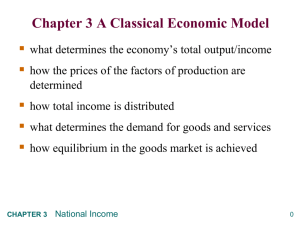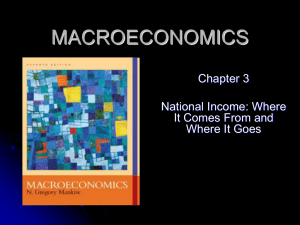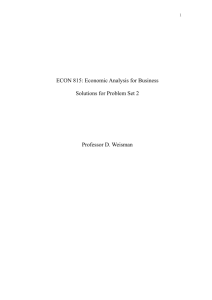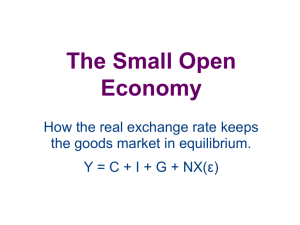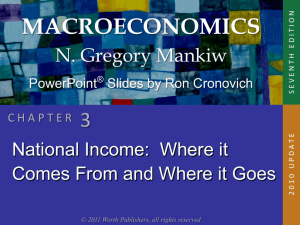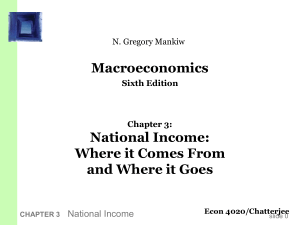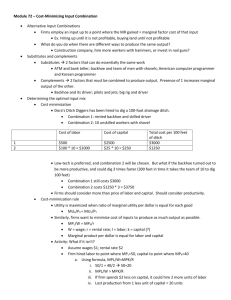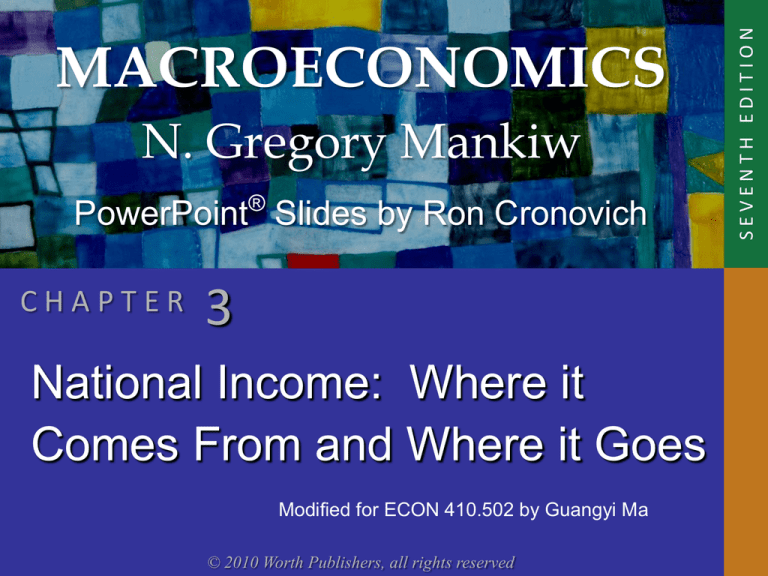
N. Gregory Mankiw
PowerPoint® Slides by Ron Cronovich
CHAPTER
3
National Income: Where it
Comes From and Where it Goes
Modified for ECON 410.502 by Guangyi Ma
© 2010 Worth Publishers, all rights reserved
SEVENTH EDITION
MACROECONOMICS
In this chapter, you will learn:
what determines the economy’s total
output/income
how the prices of the factors of production are
determined
how total income is distributed
what determines the demand for goods and
services
how equilibrium in the goods market is
achieved
Outline of model
A closed economy, market-clearing model
Supply side
factor markets (supply, demand, price)
determination of output/income
Demand side
determinants of C, I, and G
Equilibrium
goods market
loanable funds market
CHAPTER 3
National Income
2
Figure 3.1 The Circular Flow of Dollars Through the Economy
CHAPTER 3
National Income
3
Factors of production
K = capital:
tools, machines, and structures used in
production
L = labor:
the physical and mental efforts of
workers
CHAPTER 3
National Income
4
The production function: Y = F(K,L)
shows how much output (Y )
the economy can produce from
K units of capital and L units of labor
reflects the economy’s level of technology
exhibits constant returns to scale (CRS)
CHAPTER 3
National Income
5
Returns to scale: A review
Initially Y1 = F (K1 , L1 )
Scale all inputs by the same factor z:
K2 = zK1 and L2 = zL1
(e.g., if z = 1.2, then all inputs are increased by 20%)
What happens to output, Y2 = F (K2, L2 )?
If constant returns to scale, Y2 = zY1
If increasing returns to scale, Y2 > zY1
If decreasing returns to scale, Y2 < zY1
CHAPTER 3
National Income
6
Returns to scale: Example 1
F (K , L)
KL
F (zK , zL)
(zK )(zL)
z 2KL
z 2 KL
z KL
z F (K , L)
CHAPTER 3
National Income
constant returns to
scale for any z > 0
7
Returns to scale: Example 2
F (K , L)
K L
F (zK , zL)
z K z L
z
CHAPTER 3
zK zL
K L
z F (K , L)
National Income
decreasing
returns to scale
for any z > 1
8
Returns to scale: Example 3
F (K , L) K 2 L2
F (zK , zL) (zK )2 (zL)2
z 2 K 2 L2
2
z F (K , L)
CHAPTER 3
National Income
increasing returns
to scale for any
z>1
9
NOW YOU TRY:
Returns to Scale
Determine whether each of these production
functions has constant, decreasing, or
increasing returns to scale:
K2
(a) F (K , L)
L
(b) F (K , L) K L
NOW YOU TRY:
Answers, part (a)
K2
F (K , L)
L
(zK )2
z 2K 2
K2
F (zK , zL)
z
zL
zL
L
z F (K , L)
constant returns to
scale for any z > 0
NOW YOU TRY:
Answers, part (b)
F (K , L) K L
F (zK , zL) zK zL
z (K L)
z F (K , L)
constant returns to
scale for any z > 0
Assumptions
1. Technology is fixed.
2. The economy’s supplies of capital and labor
are fixed at
K K
CHAPTER 3
National Income
and
LL
13
Determining GDP
Output is determined by the fixed factor supplies
and the fixed state of technology:
Y F (K , L)
CHAPTER 3
National Income
14
The distribution of national income
determined by factor prices,
the prices per unit firms pay for the factors of
production
wage = price of L
rental rate = price of K
CHAPTER 3
National Income
15
Notation
W
= nominal wage
R
= nominal rental rate
P
= price of output
W /P = real wage
(measured in units of output)
R /P = real rental rate
CHAPTER 3
National Income
16
How factor prices are determined
Factor prices are determined by supply and
demand in factor markets.
Recall: Supply of each factor is fixed.
What about demand?
CHAPTER 3
National Income
17
Demand for labor
Assume markets are competitive:
each firm takes W, R, and P as given.
Basic idea:
A firm hires each unit of labor
if the cost does not exceed the benefit.
cost = real wage
benefit = marginal product of labor
CHAPTER 3
National Income
18
Marginal product of labor (MPL )
definition:
The extra output the firm can produce
using an additional unit of labor
(holding other inputs fixed):
MPL = F (K, L +1) – F (K, L)
CHAPTER 3
National Income
19
NOW YOU TRY:
Compute & graph MPL
a. Determine MPL at each
value of L.
b. Graph the production
function.
c. Graph the MPL curve with
MPL on the vertical axis and
L on the horizontal axis.
L
0
1
2
3
4
5
6
7
8
9
10
Y
0
10
19
27
34
40
45
49
52
54
55
MPL
n.a.
?
?
8
?
?
?
?
?
?
?
NOW YOU TRY:
Answers
MPL (units of output)
Marginal Product of Labor
12
10
8
6
4
2
0
0
1
2
3
4
5
6
7
8
9 10
Labor (L)
MPL and the production function
Y
output
F (K , L )
1
MPL
MPL
As more labor is
added, MPL
1
MPL
1
Slope of the production
function equals MPL
L
labor
CHAPTER 3
National Income
22
Diminishing marginal returns
As a factor input is increased,
its marginal product falls (other things equal).
Intuition:
Suppose L while holding K fixed
fewer machines per worker
lower worker productivity
CHAPTER 3
National Income
23
NOW YOU TRY:
MPL and labor demand
Suppose W/P = 6.
If L = 3, should firm hire
more or less labor? Why?
If L = 7, should firm hire
more or less labor? Why?
L
0
1
2
3
4
5
6
7
8
9
10
Y MPL
0 n.a.
10
10
19
9
27
8
34
7
40
6
45
5
49
4
52
3
54
2
55
1
MPL and the demand for labor
Units of
output
Each firm hires labor
up to the point where
MPL = W/P.
Real
wage
MPL,
Labor
demand
Units of labor, L
Quantity of labor
demanded
CHAPTER 3
National Income
26
The equilibrium real wage
Units of
output
Labor
supply
equilibrium
real wage
L
CHAPTER 3
National Income
The real wage
adjusts to equate
labor demand
with supply.
MPL,
Labor
demand
Units of labor, L
27
Determining the rental rate
We have just seen that MPL = W/P.
The same logic shows that MPK = R/P:
diminishing returns to capital: MPK as K
The MPK curve is the firm’s demand curve
for renting capital.
Firms maximize profits by choosing K
such that MPK = R/P.
CHAPTER 3
National Income
28
The equilibrium real rental rate
Units of
output
Supply of
capital
equilibrium
R/P
K
CHAPTER 3
National Income
The real rental rate
adjusts to equate
demand for capital
with supply.
MPK,
demand for
capital
Units of capital, K
29
The Neoclassical Theory of Distribution
states that each factor input is paid its marginal
product
real wage = MPL
real rental price of capital = MPK
a good starting point for thinking about income
distribution
CHAPTER 3
National Income
30
How income is distributed to L and K
W
L MPL L
total labor income =
P
R
K MPK K
total capital income =
P
If production function has constant returns to
scale, then
Y MPL L MPK K
national
income
CHAPTER 3
National Income
labor
income
capital
income
31
How income is distributed to L and K
If we define the economic profit as
Economic Profit = Y ( MPL L) ( MPK K )
Then under our assumptions (CRS technology,
competitive and profit maximizing firms), the
economic profit must be zero.
Note the difference between this “economic
profit” and the commonly used term “profit”.
CHAPTER 3
National Income
32
The ratio of labor income to total income
in the U.S., 1960-2007
Labor’s 1.0
share of
total
0.8
income
0.6
0.4
0.2
Labor’s share of income
is approximately constant over time.
(Thus, capital’s share is, too.)
0.0
1960 1965 1970 1975 1980 1985 1990 1995 2000 2005
The Cobb-Douglas Production Function
The Cobb-Douglas production function has
constant factor shares:
= capital’s share of total income:
capital income = MPK x K = Y
labor income = MPL x L = (1 – )Y
The Cobb-Douglas production function is:
F K , L AK L
1
where A (>0) represents the level of technology.
CHAPTER 3
National Income
34
The Cobb-Douglas Production Function
Each factor’s marginal product is proportional to
its average product:
MPK AK
1 1
L
Y
K
(1 )Y
MPL (1 ) AK L
L
CHAPTER 3
National Income
35
Labor productivity and wages
Theory: wages depend on labor productivity
U.S. data:
CHAPTER 3
period
Labor
productivity
growth
real wage
growth
1959-2007
2.1%
2.0%
1959-1973
2.8%
2.8%
1973-1995
1.4%
1.2%
1995-2007
2.5%
2.4%
National Income
36
Outline of model
A closed economy, market-clearing model
Supply side
DONE
factor markets (supply, demand, price)
DONE
determination of output/income
Demand side
Next determinants of C, I, and G
Equilibrium
goods market
loanable funds market
CHAPTER 3
National Income
37
Demand for goods & services
Components of aggregate demand:
C = consumer demand for goods & services
I = demand for investment goods
G = government demand for goods & services
(closed economy: no NX )
CHAPTER 3
National Income
38
Consumption, C
def: Disposable income is total income minus
total taxes:
Y – T.
Consumption function: C = C (Y – T )
Shows that (Y – T ) C
def: Marginal propensity to consume (MPC)
is the change in C when disposable income
increases by one dollar.
CHAPTER 3
National Income
39
The consumption function
C
C (Y –T )
MPC
1
The slope of the
consumption function
is the MPC.
Y–T
CHAPTER 3
National Income
40
Investment, I
The investment function is I = I (r ),
where r denotes the real interest rate,
the nominal interest rate corrected for inflation.
The real interest rate is
the cost of borrowing
the opportunity cost of using one’s own
funds to finance investment spending
So, r I
CHAPTER 3
National Income
41
The investment function
r
Spending on
investment goods
depends negatively on
the real interest rate.
I (r )
I
CHAPTER 3
National Income
42
Government spending, G
G = govt spending on goods and services.
G excludes transfer payments
(e.g., social security benefits,
unemployment insurance benefits).
Assume government spending and total taxes
are exogenous:
G G
CHAPTER 3
National Income
and
T T
43
The market for goods & services
Aggregate demand:
Aggregate supply:
Equilibrium:
C (Y T ) I (r ) G
Y F (K , L )
Y = C (Y T ) I (r ) G
The real interest rate adjusts
to equate demand with supply.
The value is called the “equilibrium interest rate”
CHAPTER 3
National Income
44
The loanable funds market
A simple supply-demand model of the financial
system.
One asset: “loanable funds”
demand for funds: investment
supply of funds: saving
“price” of funds:
real interest rate
CHAPTER 3
National Income
45
Demand for funds: Investment
The demand for loanable funds…
comes from investment:
Firms borrow to finance spending on plant &
equipment, new office buildings, etc.
Consumers borrow to buy new houses.
depends negatively on r,
the “price” of loanable funds
(cost of borrowing).
CHAPTER 3
National Income
46
Loanable funds demand curve
r
The investment
curve is also the
demand curve for
loanable funds.
I (r )
I
CHAPTER 3
National Income
47
Supply of funds: Saving
Supply of loanable funds comes from saving:
Private saving: households use their saving to
make bank deposits, purchase bonds and other
assets. These funds become available to firms
to borrow to finance investment spending.
Public saving: The government may also
contribute to saving if it does not spend all the
tax revenue it receives.
CHAPTER 3
National Income
48
Types of saving
private saving = (Y – T ) – C
public saving
=
T – G
national saving, S
= private saving + public saving
= (Y –T ) – C +
=
CHAPTER 3
T–G
Y – C – G
National Income
49
Budget surpluses and deficits
If T > G, budget surplus = (T – G)
= public saving.
If T < G, budget deficit = (G – T)
and public saving is negative.
If T = G, “balanced budget,” public saving = 0.
The U.S. government finances its deficit by
issuing Treasury bonds – i.e., borrowing.
CHAPTER 3
National Income
53
U.S. Federal Government Surplus/Deficit,
1940-2007
10%
5%
0%
-5%
-10%
-15%
-20%
-25%
-30%
1940
1950
1960
1970
1980
1990
2000
2010
U.S. Federal Government Debt,
1940-2007
140%
Fact: In the early 1990s, about
18 cents of every tax dollar went
to pay interest on the debt.
(In 2007, it was about 10 cents)
120%
100%
80%
60%
40%
20%
0%
1940
1950
1960
1970
1980
1990
2000
2010
Loanable funds supply curve
r
S Y C (Y T ) G
National saving
does not
depend on r,
so the supply
curve is vertical.
S, I
CHAPTER 3
National Income
56
Loanable funds market equilibrium
r
S Y C (Y T ) G
Equilibrium real
interest rate
I (r )
Equilibrium level
of investment
CHAPTER 3
National Income
S, I
57
The special role of r
r adjusts to equilibrate the goods market and the
loanable funds market simultaneously:
If L.F. market in equilibrium, then
Y–C–G =I
Add (C +G ) to both sides to get
Y = C + I + G (goods market eq’m)
Thus,
CHAPTER 3
Eq’m in L.F.
market
National Income
Eq’m in goods
market
58
Mastering the loanable funds model
Things that shift the saving curve
public saving
fiscal policy: changes in G or T
private saving
preferences
tax laws that affect saving
– 401(k)
– IRA
– replace income tax with consumption tax
CHAPTER 3
National Income
60
CASE STUDY:
The Reagan deficits
Reagan policies during early 1980s:
increases in defense spending: G > 0
big tax cuts: T < 0
Both policies reduce national saving:
S Y C (Y T ) G
G S
CHAPTER 3
National Income
T C S
61
CASE STUDY:
The Reagan deficits
1. The increase in
the deficit
reduces saving…
2. …which causes
the real interest
rate to rise…
3. …which reduces
the level of
investment.
CHAPTER 3
National Income
r
S2
S1
r2
r1
I (r )
I2
I1
S, I
62
Are the data consistent with these results?
variable
1970s
1980s
T–G
–2.2
–3.9
S
19.6
17.4
r
1.1
6.3
I
19.9
19.4
T–G, S, and I are expressed as a percent of GDP
All figures are averages over the decade shown.
CHAPTER 3
National Income
63
Mastering the loanable funds model,
continued
Things that shift the investment curve:
some technological innovations
to take advantage some innovations,
firms must buy new investment goods
tax laws that affect investment
e.g., investment tax credit
CHAPTER 3
National Income
65
An increase in investment demand
r
…raises the
interest rate.
r2
S
An increase
in desired
investment…
r1
But the equilibrium
level of investment
cannot increase
because the
supply of loanable
funds is fixed.
CHAPTER 3
National Income
I1
I2
S, I
66
Saving and the interest rate
Why might saving depend on r ?
How would the results of an increase in
investment demand be different?
Would r rise as much?
Would the equilibrium value of I change?
CHAPTER 3
National Income
67
An increase in investment demand when
saving depends on r
An increase in
investment demand
raises r,
which induces an
increase in the
quantity of saving,
which allows I
to increase.
r
S (r )
r2
r1
I(r)2
I(r)
I1 I2
CHAPTER 3
National Income
S, I
68
Chapter Summary
Total output is determined by:
the economy’s quantities of capital and labor
the level of technology
Competitive firms hire each factor until its
marginal product equals its price.
If the production function has constant returns
to scale, then labor income plus capital
income equals total income (output).
Chapter Summary
A closed economy’s output is used for:
consumption
investment
government spending
The real interest rate adjusts to equate
the demand for and supply of:
goods and services
loanable funds
Chapter Summary
A decrease in national saving causes the
interest rate to rise and investment to fall.
An increase in investment demand causes the
interest rate to rise, but does not affect the
equilibrium level of investment if the supply of
loanable funds is fixed.

